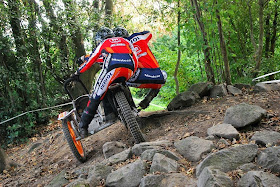2013/11/10
5 Stroke engine by Belgian inventor Gerhard Schmitz - Ilmor
Info: 5-stroke-engine.com or 5-takt-motor.com
Info: jodocy-schmitz.com
The engine concept, which was invented by Gerhard Schmitz, has been developed by Ilmor into a working engine using a rapid prototype cast cylinder head, a machined from solid cylinder block and separate electrically powered oil and water pumps. Two overhead camshafts operate the conventional coil spring valvegear with the HP camshaft running at 0.5 x crank speed and the LP camshaft running at 1 x crank speed. The engine is also turbocharged to increase the engine rating.
5-stroke performance figures
- Engine capacity 700cc (turbocharged)
- Peak power 130 bhp @ 7000 rpm
- Peak torque 166 Nm @ 5000 rpm
- Fuel consumption of only 226 g/kWh
Advantages of the 5-stroke concept
- A secondary cylinder provides an additional expansion process enabling extra work to be extracted, hence increasing thermodynamic efficiency.
- The engine runs an overall expansion ratio approaching that of a diesel engine – in the region of 14.5:1
- Minimised pumping work due to the downsizing effect from highly rated firing cylinders.
- The compression ratio can be reduced to delay knock onset without a reduction in performance.
- Because the firing cylinders can be very highly rated, the engine is relatively compact.
- The fuel consumption does not rise as rapidly with increasing BMEP, as retarding rejects more energy into the expansion cylinder.
- The engine uses 100% conventional technology and so requires no new manufacturing techniques.
Principle of operation
The 5-stroke concept engine utilises two fired cylinders (High Pressure - HP) operating on a conventional 4-stroke cycle which alternately exhaust into a central expansion cylinder (Low Pressure - LP), whereupon the burnt gases perform further work. The LP cylinder decouples the expansion and compression processes and enables the optimum expansion ratio to be selected independently of the compression ratio.Running of the concept engine has produced impressive fuel consumption readings over a very wide operating range. This is because at the onset of knock a greater percentage of work can be extracted in the LP cylinder, giving a degree of self compensation.
Text via: ilmor.co.uk
Info: ilmor.co.uk
Billy Al Bengston - Art & Motorcycles
Billy Al Bengston on a his BSA Victor motorcycle in
the Ballona Wetlands, Marina del Rey, California,
1966. Image courtesy of and © Billy Al Bengston
Via: getty.edu
Via: lonecubcrywolf.blogspot
Via: venice-in-venice.com
BENGSTON'S ART

Billy Al Bengston, Skinny’s 21, 1961 signed with initials and dated ‘B.A.B. / 1961
Via: jockohomo
Sonny, 1961, Billy Al Bengston. Oil on Masonite. 36 x 36 in. Billy Al Bengston Studio Holdings. © Billy Al Bengston. Photo by Brian Forrest
Via: getty.edu
Big Jim McLain, 1967, Billy Al Bengston. Polyurethane and laquer on aluminum. 60 x 58 in. Collection of Joan and Jack Quinn. © Billy Al Bengston
Via: getty.edu
Billy Al Bengston’s studio at Clark Street and Santa Monica Boulevard, Los Angeles, 1957. Image courtesy of and © Billy Al Bengston
Big
Jim McLain, 1967, Billy Al Bengston. Polyurethane and laquer on
aluminum. 60 x 58 in. Collection of Joan and Jack Quinn. © Billy Al
Bengston - See more at:
http://blogs.getty.edu/pacificstandardtime/explore-the-era/worksofart/big-jim-mcclain/#sthash.hC9cGXp9.dpuf
Via: getty.edu
B. A. Bengston official: billyalbengston.com
Info: wikipedia - Billy Al Bengston











































